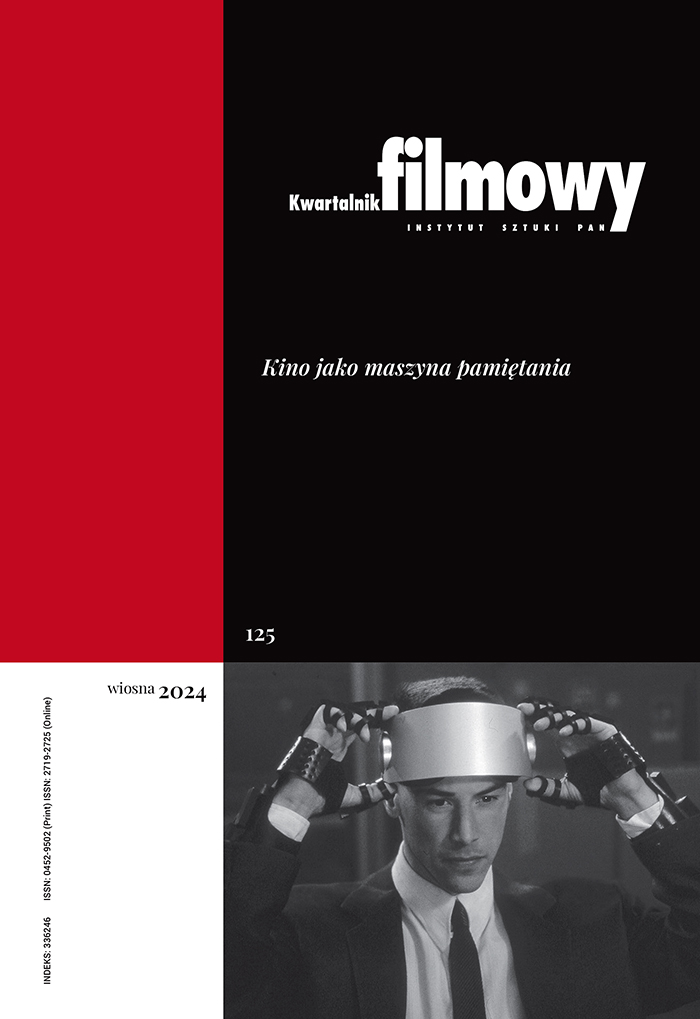The Brand of the Past, or the Traumatic Identity in Atom Egoyan’s “Adoration”
Abstract
Adoration (2008) sums up many of the themes present in Egoyan’s earlier work. We find here transformed and re-contextualized themes of family breakdown, death of a close person and identity crisis. The film lacks temporal and space continuity, and elliptic editing is applied, which makes it difficult to order the events chronologically. From the very beginning the present is connected with the past, and the director purposefully misleads the viewer, laying false trails, and referring the viewer to absent elements, to events from the past. Loska notes that the narrative structure of Adoration is based on association, and not on cause and effect, as it is built upon associating apparently unconnected elements. The storyline consists of several narrative streams and numerous ellipses and repetitions that lead to mutually exclusive versions of events. Loska presents these elements of the narrative in detail, and concludes that the trauma experienced by the main character cannot be shown directly or presented within the framework of a linear storyline, as the traumatic experience is beyond rationalization and ordering.
Keywords:
Atom Egoyan, narrative, trauma, identityReferences
Boym Svetlana, The Future of Nostalgia, Basic Books, New York 2000, s. XVIII.
Google Scholar
Dąbrowski Mieczysław, Swój/obcy/inny, Świat Literacki, Warszawa 2001, s. 82.
Google Scholar
Deleuze Gilles, Kino, tłum. J. Margański, Słowo/obraz terytoria, Gdańsk 2008.
Google Scholar
Freud Zygmunt, Żałoba i melancholia, tłum. B. Kocowska, w: K. Pospiszyl, Zygmunt Freud. Człowiek i dzieło, Ossolineum, Wrocław 1991, s. 295-308.
Google Scholar
Giddens Anthony, Nowoczesność i tożsamość, tłum. A. Szulżycka, PWN, Warszawa 2001, s. 232.
Google Scholar
Kaplan E. Ann, Performing Traumatic Dialogue, „Women and Performance”, 1998, nr 19-20, s. 34.
Google Scholar
Lageira Jacinto, The Recollection of Scattered Parts, w: C. Desbarats i in., Atom Egoyan, tłum. B. Holmes, Dis Voir, Paris 1993, s. 46.
Google Scholar
Laing Ronald David, „Ja” i inni, tłum. B. Mizia, Rebis, Poznań 1997, s. 106.
Google Scholar
Lasch Christopher, The Culture of Narcissism: American Life in an Age of Diminishing Expectations, W. W. Norton, New York 1991, s. 7-10.
Google Scholar
Lowenthal David, Przeszłość to obcy kraj, „Res Publica”, 1991, nr 3, s. 10.
Google Scholar
Melchior Małgorzata, Społeczna tożsamość jednostki, Uniwersytet Warszawski, Warszawa 1995, s. 27.
Google Scholar
Romney Jonathan, Atom Egoyan, BFI Publishing, London 2003, s. 117.
Google Scholar
Taylor Charles, Źródła podmiotowości: Narodziny tożsamości nowoczesnej, PWN, Warszawa 2000, s. 53.
Google Scholar
Tschofen Monique, Jennifer Burwell, In Media Res: Atom Egoyan’s Utopian Praxis, w: Image and Territory: Essays on Atom Egoyan, red. M. Tschofen, J Burwell, Wilfrid Laurier University Press, Waterloo 2007, s. 1.
DOI: https://doi.org/10.51644/9780889205291-002
Google Scholar
Welsch Wolfgang, Stając się sobą, tłum. J. Wietecki, w: Problemy ponowoczesnej pluralizacji kultury. Wokół koncepcji Wolfganga Welscha, red. A. Zeidler-Janiszewska, Wydawnictwo Fundacji Humaniora, Poznań 1998, s. 26, 31
Google Scholar
Authors
Krzysztof Loskakwartalnik.filmowy@ispan.pl
Jagiellonian University Poland
Profesor UJ; zajmuje się kulturą popularną, postmodernizmem, literaturą współczesną i kinem gatunkowym. Autor m.in. Dziedzictwa McLuhana. Między nowoczesnością a ponowoczesnością (2001), Encyklopedii filmu science fiction (2004), Tożsamości i mediów (2006). Współautor (z Andrzejem Pitrusem) książek: 100 filmów science fiction (2000) i David Cronenberg: rozpad ciała, rozpad gatunku (2003).
Statistics
Abstract views: 604PDF downloads: 139
License
Copyright (c) 2010 Krzysztof Loska

This work is licensed under a Creative Commons Attribution 4.0 International License.
The author grants the publisher a royalty-free non-exclusive licence (CC BY 4.0) to use the article in Kwartalnik Filmowy, retains full copyright, and agrees to identify the work as first having been published in Kwartalnik Filmowy should it be published or used again (download licence agreement). The journal is published under the CC BY 4.0 licence. By submitting an article, the author agrees to make it available under this licence.
In issues from 105-106 (2019) to 119 (2022) all articles were published under the CC BY-NC-ND 4.0 licence. During this period the authors granted a royalty-free non-exclusive licence (CC BY-ND 4.0) to use their article in „Kwartalnik Filmowy”, retained full copyright, and agreed to identify the work as first having been published in our journal should it be published or used again.
Most read articles by the same author(s)
- Krzysztof Loska, „Tropical Malady”, or on Humans, Animals and Spirits in Apichatpong Weerasethakul’s film , Kwartalnik Filmowy: No. 110 (2020): Beyond Human Being
- Krzysztof Loska, Histories of Polish Migrants in European Cinema , Kwartalnik Filmowy: No. 109 (2020): Architectural Space in Film
- Krzysztof Loska, Architecture and Japanese Colonialism – Cinematic Image of Cityscape in Occupied Seoul , Kwartalnik Filmowy: No. 109 (2020): Architectural Space in Film
- Krzysztof Loska, Journey to the New World. Cinematic Ethnographic Fiction in Post-Colonial Perspective , Kwartalnik Filmowy: No. 107 (2019): Journey, (E)migration, Pilgrimage
- Krzysztof Loska, Apichatpong Weerasethakul – About Politics and Spectres , Kwartalnik Filmowy: No. 105-106 (2019): Cinema and Political Transformation
- Krzysztof Loska, From the Point of View of Indigenous Peoples: Film as a Tool of Decolonization in Canada , Kwartalnik Filmowy: No. 116 (2021): Cinema and Social Identity
- Krzysztof Loska, Teinosuke Kinugasa, Neosensualism and the Avant-Garde , Kwartalnik Filmowy: No. 82 (2013): Experiment: Film and Audiovisual Arts
- Krzysztof Loska, Memory, Performance and Affects – Genocide in the Films by Joshua Oppenheimer , Kwartalnik Filmowy: No. 111 (2020): Senses and Affects
- Krzysztof Loska, Oscar Micheaux and the Beginnings of African-American Cinema , Kwartalnik Filmowy: No. 117 (2022): Unknown/Hidden Cinema
- Krzysztof Loska, Contemporary Horror in the Guise of Found Footage , Kwartalnik Filmowy: No. 104 (2018): Essay, Found Footage, Compilation Film











